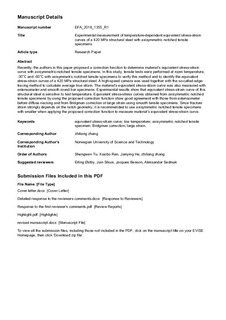| dc.contributor.author | Tu, Shengwen | |
| dc.contributor.author | Ren, Xiaobo | |
| dc.contributor.author | He, Jianying | |
| dc.contributor.author | Zhang, Zhiliang | |
| dc.date.accessioned | 2019-03-29T09:37:26Z | |
| dc.date.available | 2019-03-29T09:37:26Z | |
| dc.date.created | 2019-02-28T11:11:58Z | |
| dc.date.issued | 2019 | |
| dc.identifier.issn | 1350-6307 | |
| dc.identifier.uri | http://hdl.handle.net/11250/2592389 | |
| dc.description.abstract | Recently, the authors in this paper proposed a correction function to determine material’s equivalent stress-strain curve with axisymmetric-notched tensile specimens. In this study, tensile tests were performed at room temperature, -30℃ and -60℃ with axisymmetric notched tensile specimens to verify this method and to identify the equivalent stress-strain curves of a 420 MPa structural steel. A high-speed camera was used together with the so-called edge-tracing method to calculate average true strain. The material’s equivalent stress-strain curve was also measured with extensometer and smooth round bar specimens. Experimental results show that equivalent stress-strain curve of this structural steel is sensitive to test temperature. Equivalent stress-stress curves obtained from axisymmetric notched tensile specimens by using the proposed correction function show good agreement with those from extensometer before diffuse necking and from Bridgman correction at large strain using smooth tensile specimens. Since fracture strain strongly depends on the notch geometry, it is recommended to use axisymmetric notched tensile specimens with smaller when applying the proposed correction function to measure material’s equivalent stress-strain curve. | nb_NO |
| dc.language.iso | eng | nb_NO |
| dc.publisher | Elsevier | nb_NO |
| dc.rights | Attribution-NonCommercial-NoDerivatives 4.0 Internasjonal | * |
| dc.rights.uri | http://creativecommons.org/licenses/by-nc-nd/4.0/deed.no | * |
| dc.title | Experimental measurement of temperature-dependent equivalent stress-strain curves of a 420 MPa structural steel with axisymmetric notched tensile specimens | nb_NO |
| dc.type | Journal article | nb_NO |
| dc.type | Peer reviewed | nb_NO |
| dc.description.version | acceptedVersion | nb_NO |
| dc.source.journal | Engineering Failure Analysis | nb_NO |
| dc.identifier.doi | https://doi.org/10.1016/j.engfailanal.2019.02.043 | |
| dc.identifier.cristin | 1681268 | |
| dc.relation.project | Norges forskningsråd: 228513 | nb_NO |
| dc.description.localcode | © 2019. This is the authors’ accepted and refereed manuscript to the article. Locked until 28.2.2021 due to copyright restrictions. This manuscript version is made available under the CC-BY-NC-ND 4.0 license http://creativecommons.org/licenses/by-nc-nd/4.0/ | nb_NO |
| cristin.unitcode | 194,64,45,0 | |
| cristin.unitname | Institutt for konstruksjonsteknikk | |
| cristin.ispublished | false | |
| cristin.fulltext | postprint | |
| cristin.qualitycode | 1 | |

